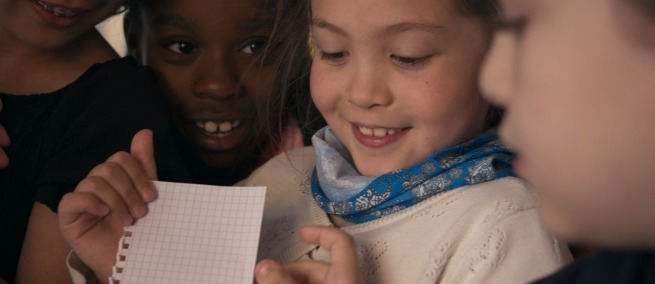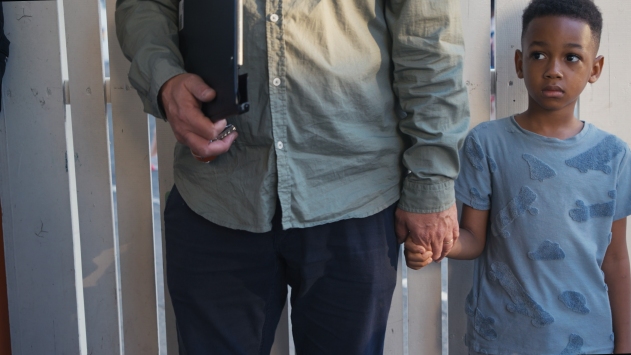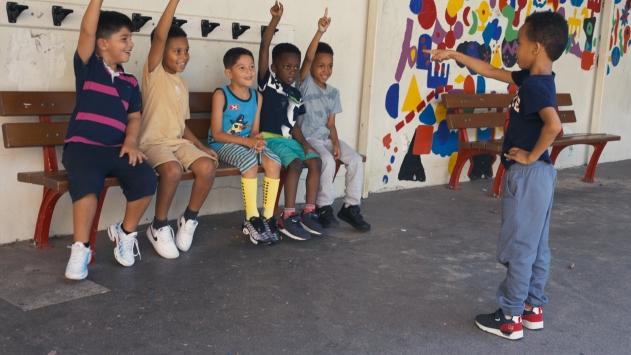
Last year, Claire Simon’s critically acclaimed OUR BODY (2023) sat with patients at a women’s hospital and joined the director herself as she dealt with cancer. In ELEMENTARY, Simon takes us into the more playful environment of a school on the edge of Paris where students hail from a diverse immigrant community. It’s not life-and-death, but to the children, every moment can feel that way, as they grapple with their math and music, learn to debate one another, and sing Rihanna. (The French title, APPRENDRE, neatly means both “learn” and “teach.”) Last month, ELEMENTARY had its world premiere at the Cannes film festival, where I sat down with Simon on a sunny day to ask her about the art and science of filming children in a school environment, something she’s done before in RECREATIONS (1998).
Where is the school located and why did you choose it?
It’s as if I was in Queens or something like that. The school is one kilometer from the entrance of Paris. I had been scouting a bit in Paris, because at the beginning I wanted to film only in the courtyard and the courtyards were very nice and new because they had been changed for the girls. They used to be only devoted to football, so the girls had to wait against the walls. But the children were from a wealthier background in these schools, so I went to the suburbs. I had done a film in Ivry, YOUNG SOLITUDE (2008), and I liked the high school very much. I loved this school because the courtyard was very big and open, and I love the yellow and orange look of the school in the middle of the gray surroundings. And I loved the director of the school. I realized that most of the children came from the surrounding buildings and that there were a lot of immigrants, and it was very interesting.
At one point you follow a new student entering the gates of the school. When in the school year were you shooting?
I shot it in May, June, the beginning of July, and then the beginning of the next year. Because if you film in a school, it is a rule for me: you have to film when the children and the teachers know each other. Otherwise, it takes a lot of time to see [what you need to see]. I had done this film PLAYTIME [aka RECREATIONS] about a kindergarten courtyard 30 years ago and it was the same: I filmed in May and June. I didn’t want the idea that [the film] was all year, but it was important to show how the children were welcome in that school with the first sequence. I thought it was so beautiful how he takes the child by the hand every time, and then we can see the world from the point of view of the child. But the reality is, yes, I’ve been cheating because that’s at the beginning of the [next] year. By May, June, and the beginning of July, the classes were well organized, and the children knew each other in the courtyard, so it was more interesting.

Still from ELEMENTARY
It felt like you were filming at the level of the children. How are you holding the camera and what kind of camera is it?
It’s a photography camera, the [Sony] FX3. And I had a screen because to be outside you have to have a screen otherwise you see nothing. You can’t have a viewer. But it’s fine. We bought the camera with my producer for that purpose, to be able to film at that good level. It’s perfect for me to film at their level.
It’s terrific because you’re not looking down at the students.
No, of course!
And the perspective also makes the children look like little adults.
Of course! But it’s because when you film even children, they are heroes. You don’t think of them as they will grow up, you think of them as the characters they are.
Were there children you realized early on you wanted to follow?
Yeah, I love the one that is playing as if he was in Roland-Garros [a tennis tournament in Paris], how he turns his head. He’s such a great actor! There was another one that I thought was like Jacques Villeret, a famous actor in France. He was so funny and great. I filmed him for a very long time with the teacher saying to him, “Come on!” But what I liked and what I wanted is the relationship between the children and the teachers, because you could see in the faces of the children their emotions and what they felt all the time. And the terror: “Oh I was wrong!”
What was different since the last time you made a documentary in a school?
Well, when I arrived they all did TikTok [poses]. I had to tell them that they looked terrible. And if they wanted to look nice, they had to stop. Because the film will never go on the social network! So they said, “Okay okay okay... but come and film the football!”
So you mean they’re more aware, more presentational?
Yeah, yeah, yeah.
The pedagogy in the school is fascinating, the topics they’re talking about, like the discussion about religion. Some kids already had very definite ideas about how people should behave.
[laughs] Yeah, that’s Wassim, the little boy. He’s hyperactive. The teacher was often fed up with him. But this work that they do in all the classes is called “cultural mediation.” It’s the morning or the afternoon, and we see two examples in the film: the story about Orphée and the story about religion. The teacher also reads a chapter from Jules Verne.

Still from ELEMENTARY
Right, about Phineas Fogg from AROUND THE WORLD IN EIGHTY DAYS!
Yeah! So then there are questions to see if they have understood the story well, and then there is a debate about one idea, a philosophical topic. And so in Elodie’s class, they put the children in groups of four, and one has to tell the whole class what they have said. It is to make them think and debate, and I had this incredible luck with the topic of religion. But what is also incredible is they laugh a lot about it.
In another sequence, they’re singing this very melancholic song about love. What is that song?
Oh that’s by Bigflo. It’s a wonderful song and the clip is so good! “It’s a pity you didn’t go and tell her you love her, it’s a pity you didn’t do it, it’s a pity.” The children chose the song. And they don’t understand exactly because in the end it’s about femicide: a mother is beaten and killed by her husband. They were just trying to sing it properly preparing for the end of the year. That’s why I show them in the courtyard singing “Diamonds” [by Rihanna]. It’s a cultural question: they are not listening to Schubert at home but probably they will listen to Rihanna. You can see they are very good at Rihanna’s music.
The math class is taught in a wonderfully natural way. Was part of that showing how a teacher could connect with the students?
Yeah, and they are in the first grade, they’re the smallest. So they’re very good, in fact. [snaps fingers] We wanted to show the natural academic learning at the beginning, and also go against the idea that they are stupid because they are children of immigrants. And I love the way you can see the little boy who has to count it out in his head. [laughs]
Any time the children were not in the shot, it was less interesting. I used to have a lot of [scenes of] discussions between the director of the school and teachers. But the editor kept telling me that it’s useless to have only an adult in the scene.
That reflects the philosophy of the film, because you’re centering on the kids and their choices, more than the teachers.
Yeah, yeah, yeah. And their emotions.
And you’re so good at catching those emotional moments. There are movies about classrooms that don’t do it this well.
What’s important is that it’s an ordinary school. I liked very much the film that won the Silver Bear in Berlin called MR. BACHMANN AND HIS CLASS (2021). But it’s not an ordinary class, it’s a class for immigrants to learn to be in [a new country]. [In ELEMENTARY] this is an ordinary school. I really like ordinary things, I’m very sorry. You know, average schools, average hospitals, all average, because it’s more important. It’s like the first time I did a fiction [film] about family planning, and I remember that what moved me the most was when a girl had forgotten her pill. Because then you realize that you have to take it every day, that it changes the whole world, the fact that you had the pill, and what it meant for her. This is the most ordinary thing! And it tells the most about us, you know? It’s not exceptional, it’s just everyday life.
ELEMENTARY is definitely a movie I want to see again to watch what everyone’s doing on screen.
I hope it will be released in the U.S., because it was really strong for me to have OUR BODY there and also THE COMPETITION (2016). I must thank the Americans. Critics in America have been nice to me.
It’s different in France?
I think that for example to show a film in the country, France is the best place, because we have art houses everywhere, everyone goes to the movies, and when we do a premiere of a documentary there are 300 people in the room, and that’s wonderful. But in America... I don’t know, I feel grateful. I had this prize in True/False [film festival], and it was really nice. I said to one of the heads of French TV, “Look, in the States, it’s private enterprise everywhere, but PBS helped Fred Wiseman from the beginning to the end, and they can be really proud of that. Can you tell me who you helped?” And he said, “You’re right.”
Did you see the Frederick Wiseman film that screened in Cannes Classics, LAW AND ORDER (1969)?
I know it by heart. We gave him the Carrosse d’Or [a special tribute award in Directors’ Fortnight] three years ago, and I was the most activist about [the award]. I had crossed paths with Wiseman several times, but we became very good friends. I really like all his work—and the person! He’s so nice. As a filmmaker, I would never have these discussions with Godard, and I have them with Wiseman! He was so generous and supportive when I did OUR BODY, and he knew I was sick. He said, “I can help you, I can do anything you want.” And we were talking: “Hospitals are just great to film in, yes. And the end of life—it’s the best, you know?” We had so much fun.
Have you shown ELEMENTARY to the school yet?
Not to the children, but the teachers loved the film. It’s the first protagonist that I have in a film that has such a precise view of the film. They said, this is really our school. They were here with me in Cannes, the school’s director and all the teachers. We walked on the [red carpet] steps, we had the dresses and everything. We are doing a screening in the cinema of Ivry in June with the children and the parents. I hope the children will shout during the screening!
♦
TOPICS